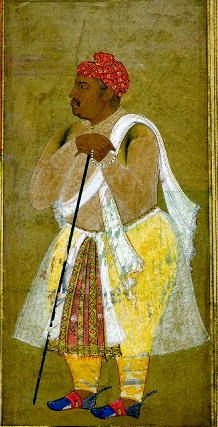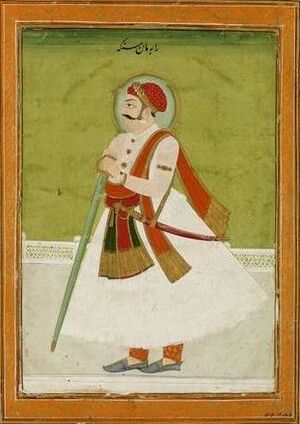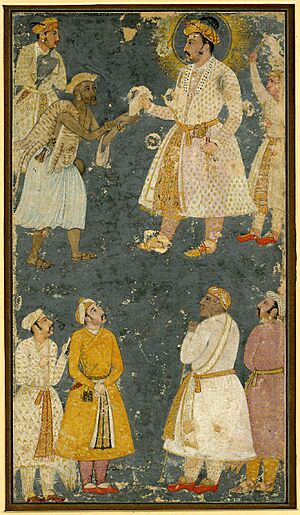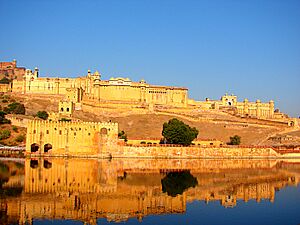Man Singh I facts for kids
Quick facts for kids Man Singh I |
|||||
|---|---|---|---|---|---|
| Maharaja of Amber Mirza Raja |
|||||
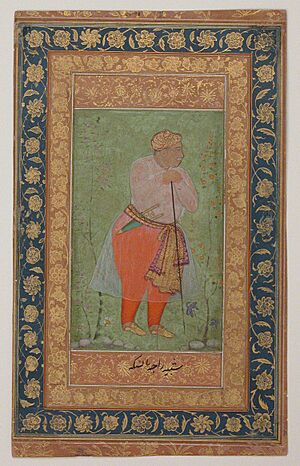
Portrait of Man Singh, c. 1590
|
|||||
| 24th Raja of Amber | |||||
| Reign | 10 December 1589 – 6 July 1614 |
||||
| Coronation | 10 December 1589 | ||||
| Predecessor | Bhagwant Das | ||||
| Successor | Bhau Singh | ||||
| 9th Subahdar of Bengal | |||||
| Term | 9 November 1595 – 2 September 1606 | ||||
| Emperor | Akbar I Jahangir |
||||
| Predecessor | Syed Khan | ||||
| Successor | Qutubuddin Khan | ||||
| Subahdar of Kabul | |||||
| Term | 1585–1586 | ||||
| Emperor | Akbar I | ||||
| Predecessor | Mirza Muhammad Hakim | ||||
| Successor | Bhagwant Das | ||||
| Born | 21 December 1550 Amber, Amber Kingdom, (present-day Amer, Rajasthan, India) |
||||
| Died | 6 July 1614 (aged 63) Ellichpur, Berar Subah, Mughal Empire (present-day Achalpur, Maharashtra, India) |
||||
| Spouse |
|
||||
| Issue among others... |
|
||||
|
|||||
| House | Kachhwaha | ||||
| Father | Bhagwant Das | ||||
| Mother | Bhagwati Bai | ||||
| Religion | Hinduism | ||||
| Military career | |||||
| Allegiance |
|
||||
| Service | |||||
| Years of service | 1562–1614 | ||||
| Rank | Kunwar (1562–589) Mansab (1598–1605) Mansabdar (1605–1614) |
||||
Mirza Raja Man Singh I (born December 21, 1550 – died July 6, 1614) was a very important ruler and general in India. He was the 24th Raja (King) of Amber from 1589 to 1614. He also served as a governor, called a Subahdar, of Bengal and Kabul.
Man Singh was a key leader in the Mughal Army under Emperor Akbar. He fought in many important battles across different regions like Kabul, Bengal, and Central and Southern India. He was skilled in both Rajput and Mughal battle strategies. People often remember him as one of the Navaratnas, which means "nine gems," referring to the nine most talented people in Emperor Akbar's royal court.
Contents
Early Life and Rise to Power
Man Singh was born on December 21, 1550. His father was Raja Bhagwant Das of Amer.
When he was young, he was known as Kunwar (prince). After his father passed away in 1589, Emperor Akbar gave Man Singh the special title of Mirza or Raja (King). He also received a high rank called a mansab of 5,000. This meant he commanded 5,000 cavalry soldiers in the Mughal army.
Akbar thought of Man Singh like a son and even called him Farzand, which means "son." Man Singh fought many important campaigns for Akbar. In 1576, he led the Mughal Army in the famous Battle of Haldighati against the Kingdom of Mewar. He also helped rebuild the Jagannath Temple in Puri and built the Kashi Vishwanath Temple in Varanasi.
War Against Mewar
Emperor Akbar sent Man Singh to meet Maharana Pratap of Mewar. Akbar wanted Pratap to sign a peace treaty and accept Mughal rule. However, Pratap refused, which led to the Battle of Haldighati in 1576.
Maharana Pratap's army had about 3,000 horsemen, elephants, and 400 archers. Man Singh's Mughal forces were much larger, with about 10,000 horsemen, infantry, and elephants. This included 4,000 Rajput soldiers from his own kingdom of Amber.
During the battle, Pratap's army attacked first, causing some confusion in the Mughal lines. But Man Singh led a strong counter-attack, forcing Pratap to retreat. The Mughals won the battle, but they could not capture Maharana Pratap, who escaped into the hills.
Expedition to Kabul
In 1580, some Muslim officers in Akbar's empire were unhappy with his policies. They started a rebellion and declared Akbar's stepbrother, Mirza Hakim, as their emperor in Kabul. Akbar sent armies to stop the rebellion in other areas, and he himself went towards Kabul with Man Singh.
Man Singh led the advance force. Even though the River Indus was difficult to cross, Man Singh and his troops managed to get over it first. When Mirza Hakim heard this, he fled. Akbar arrived in Kabul in August 1581. Mirza Hakim was forgiven, but his sister was made the governor. After Akbar returned, Man Singh was appointed governor of Kabul. He built a fortress there that later governors used.
Later, in 1585, some Afghan tribes rebelled against the Mughal Empire. Akbar sent armies, but they struggled. One of Akbar's close friends, Raja Birbal, was even killed. Akbar then called Man Singh to help. Man Singh, along with Rao Gopaldas, bravely led the Mughal army through the difficult Khyber Pass.
After crossing the pass, Man Singh defeated five major Afghan tribes. To celebrate this big victory, the flag of Amber was changed to "Pachranga" (five-colored). This new flag was used until Jaipur became part of India. This victory brought peace to the area. In 1586, Man Singh's father helped capture Kashmir, which also became part of the Mughal Empire.
Conquest of Bihar
When Akbar conquered Delhi, many of his Afghan enemies escaped to the eastern kingdoms. Emperor Akbar sent Man Singh to bring these resisting rulers under Mughal control.
Man Singh first attacked Raja Puranmal of Gidhaur. His fort was easily captured, and Man Singh took his treasury. Man Singh continued his campaign, defeating the rulers of Gaya and Kargpur. They were forced to accept Mughal rule and pay tribute.
Some Afghan nobles from Bengal tried to invade Bihar during this time, but Man Singh's son, Jagat Singh, defeated them. The invaders left their treasures and fled back to Bengal. Man Singh sent the captured wealth and 54 elephants to Emperor Akbar. A historian named Abul Fazl praised Man Singh, saying he had "ability with courage and genius with strenuous action."
Conquest of Orissa
After his success in Bihar, Man Singh was ordered to defeat the Afghan Sultan Qatlu Khan Lohani of Orissa. Man Singh began his campaign in April 1590. His son, Jagat Singh, was sent ahead to scout the area. However, Jagat Singh was attacked by Sultan Qatlu Khan and suffered a big defeat. Many important commanders from Amber were killed. Jagat Singh was saved by Raja Hamir Singh and escaped to a fort.
Luckily, Qatlu Khan died ten days later. His son, Nasir Khan, surrendered to Man Singh. Nasir promised to accept Emperor Akbar's rule and gave 150 elephants as tribute. Man Singh then returned to Bihar.
However, the Afghans rebelled again. Man Singh had to march back to Orissa. In April 1592, the two armies met near Jaleswar city. After a fierce battle, Man Singh defeated the Afghans. He pursued them and forced the Afghan leaders to accept Mughal rule. The remaining Afghan leaders fled to the Hindu rulers of Orissa. Man Singh attacked these rulers and captured several forts easily. The strongest ruler, the Raja of Khurda, refused to surrender at first. Man Singh captured many of his cities and forts. Emperor Akbar then asked Man Singh to be less harsh, and the Khurda Raja surrendered. He even offered his daughter in marriage to Man Singh. This completed the conquest of Orissa.
Governor of Bengal, Bihar, Jharkhand and Odisha
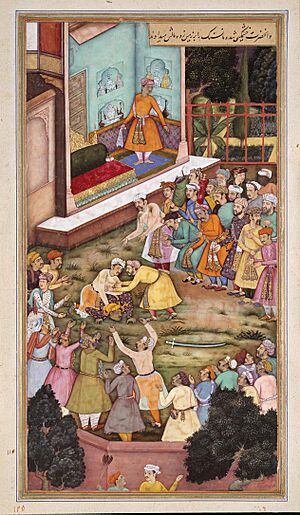
On March 17, 1594, Emperor Akbar made Man Singh the guardian of Prince Salim (who later became Emperor Jahangir). Man Singh was also appointed as the viceroy, or governor, of Bengal. He received large land grants in Orissa and Bengal.
Man Singh quickly sent his forces to stop rebellions in Bengal. In April 1595, his army conquered Bhushna fort. On November 7, Man Singh founded a new capital for Bengal called Akbarnagar. After setting up the new capital, Man Singh personally led a campaign against the Afghans under Isa Bhati. The Afghans retreated, and their lands were taken over by the Mughals.
Man Singh fell ill after this campaign, which caused new rebellions to start. He sent Himmat Singh to deal with the rebels, and they were defeated again. Man Singh also helped Lakshmi Narayan, the Raja of Cooch Behar. The grateful Raja gave his sister in marriage to Man Singh and agreed to become a vassal of the Mughal Emperor.
Man Singh later left Bengal for a short time, and during this period, the Mughals started to lose some control. So, Man Singh was sent back to Bengal. He defeated the rebels near Sherpur-Atia in February 1601. He then marched towards Dacca and forced Kedar Rai, a local leader, to submit. Man Singh's grandson also defeated other rebels. Man Singh continued his campaigns, defeating the successor of Qatlu Khan and stopping the Pathans. He also defeated the Arracan Pirates and Kedar Rai. After many victories against powerful rebels, Man Singh returned to Dacca.
Jahangir and Later Years
Prince Salim, Akbar's son, disobeyed royal orders and became known for ordering the murder of Abul Fazal, a close advisor to Akbar. Akbar tried to guide Salim and his eldest son, Khusrau Mirza. Two of Akbar's sons had already passed away.
The royal court was divided. Some people supported Khusrau to be the next emperor, while others supported Salim. Raja Man Singh and Mirza Aziz Koka were among those who favored Khusrau. However, in 1605, when Akbar fell ill, he named Salim as his heir.
Even though Man Singh had supported Khusrau earlier, he never opposed Jahangir (Salim) after he became emperor. After Akbar's death, Jahangir became the new emperor. Man Singh was briefly sent as governor of Bengal in 1605 but was soon replaced. Jahangir also ordered some changes to Man Singh's palace at Amber.
In 1611, the southern provinces of Ahmednagar, Berar, and Khandesh rebelled against Mughal rule under a leader named Malik Ambar. Jahangir sent Raja Man Singh and other generals to put down this revolt.
Spouses and Issue
Spouses
- Sushilawati Bai
- Munwari Bai
- Sahodra Gaud
- Sumitra
- Jambhvanti
- Chhamavati
- Prabhavati Bangalan
- Bibi Mubarak (Niece of Akbar)
Issue
- Kunwar Jagat Singh
- Raja Bhau Singh (died 1621)
- Kunwar Durjan Singh (1575–1597)
- Kunwar Himmat Singh (1590–1597)
- Bhogda Singh (1596–1610)
- Sabal Singh
- Raj Kuwri Mena Baisa (1591–1682)
- Manorama Bai (1614–1689)
Death and Succession
Man Singh passed away peacefully on July 6, 1614, in Ellichpur. After his death, his brother, Mirza Raja Bhau Singh, became the next ruler. Man Singh's direct family members are known as the Rajawats. They had the right to the throne of Amber and later Jaipur.
Cultural Achievements
Raja Man Singh was a devoted follower of the Hindu deity Krishna. He built a magnificent seven-story temple for Krishna in Vrindavan. This temple cost a lot of money at that time. A four-story part of this temple still stands in Vrindavan today. He also built a Krishna temple in his capital, Amber, a place now known as "Kanak Vrindavan." He constructed the temple of Shila Devi at Amber Fort.
Man Singh also built and repaired many temples in Benaras, Allahabad, and other places. He added many beautiful features to his palace at Amber.
In 1582, when Emperor Akbar discussed his new religious ideas called Din-i-Ilahi, Raja Bhagwant Das (Man Singh's father) was the only one who openly disagreed. Later, Man Singh also refused to join this new religion. It is believed that Man Singh's son, Jagat Singh I, was taught by Goswami Tulsidas. Tulsidas was a famous poet who lived at the same time as Akbar. He wrote the Ramcharitmanas, also known as the Tulasi Ramayana, and many other poems about Rama and Hanuman.
Images for kids
-
Amber Fort in Jaipur, the residence of Man Singh I.
-
Man Mandir Ghat in Varanasi built by Man Singh I.
-
Tomb of Raja Man Singh in Jhelum.
See also
- House of Kachwaha
- List of Rajputs
- Pratap Singh, Maharana of Mewar
- Origin of Rajputs
- Dara Shikoh


